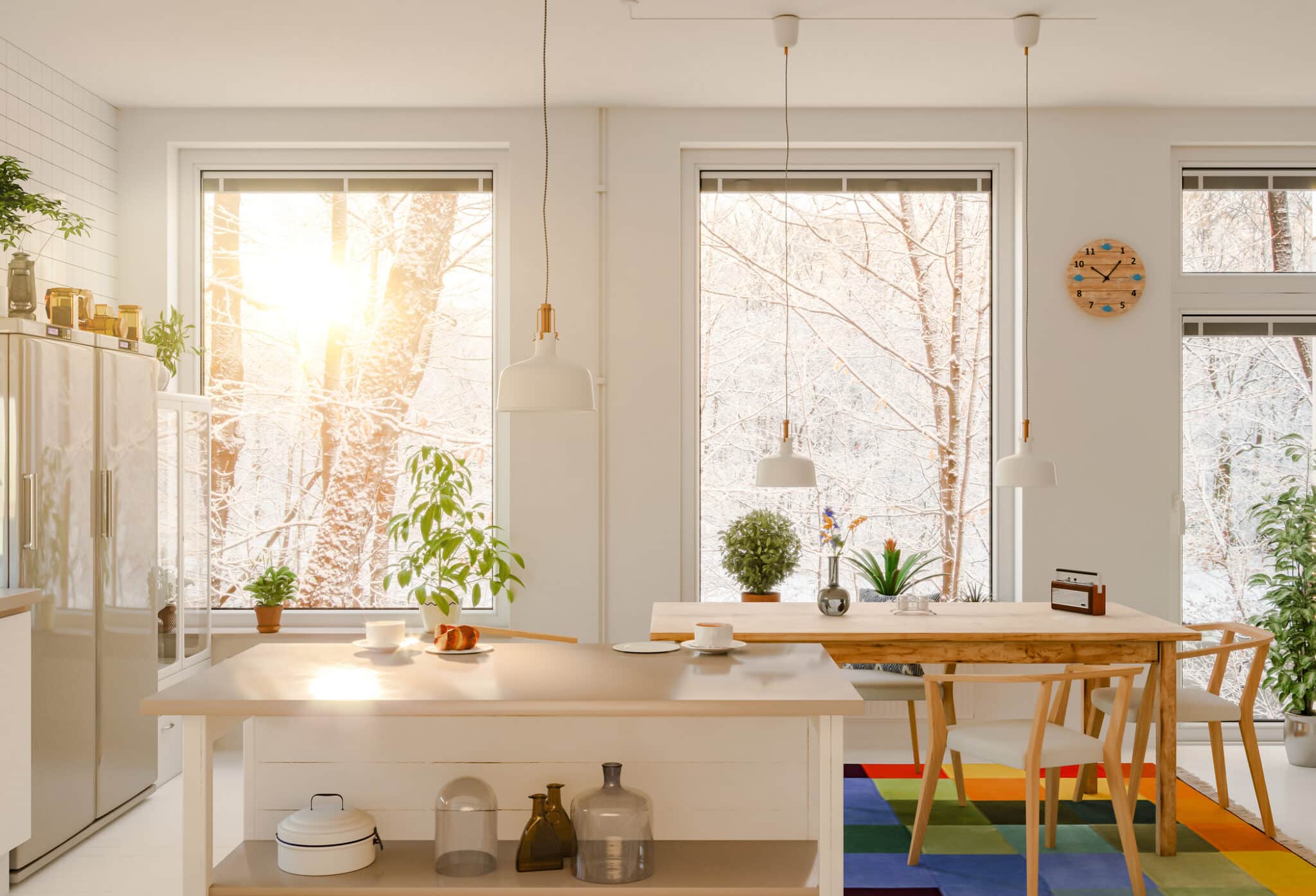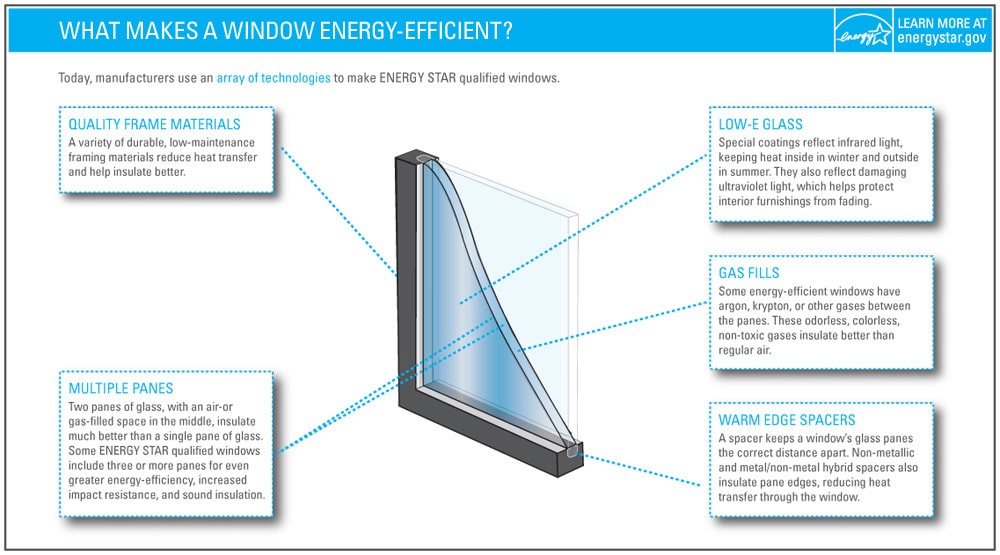Learn About Windows
Looking to upgrade your home's windows? EcoWatch is your source for all things energy-efficiency, including windows.
Get Free Quotes From Approved Window Installers
Top EcoWatch Resources for Energy-Efficient Windows
What You Need To Know About Windows
Did you know that if your windows are outdated or damaged, you could be wasting 25-30% of your home’s heat or air conditioning?1 That’s not only a waste of resources, but it means you’re paying every month for heating and cooling you’re not even using. In fact, Energy Star estimates that switching to energy-efficient windows can save the average homeowner up to $583 per year.2
But what type of window installation do you need, and how much will it cost?
Let’s start with pricing. The typical cost of a single window replacement in the U.S. is about $600, but this can range from about $200 to $1,200. The factors that will determine your window installation costs include:
- The size of window you need
- The type of material you choose
- The number of windows you need
- The location of your home
- The installer you choose
- The type of installation you need
Generally, there are two types of window installation services: full-frame and pocket installations. Full-frame installations are total window replacements, including removal and reinstallation of the window, sill, exterior trim and interior trim. Pocket installations involve replacing a window within its existing frame. Full-frame installations are more costly, as they require more materials, labor and time to complete.
The decision to go with a pocket or full-frame installation is generally based on things like the age and condition of your home, your home’s material, and your budget and time restrictions. A certified installer can help you determine the best choice for your home.
More Energy-Efficient Home Upgrades
Best Window Companies in Austin, Texas
Need new windows in Austin? See our top picks for energy-efficient options in ATX. We go through:
- Top window installers
- How to choose a window company
- The cost of windows in Austin
- Which window services you might need
- And more
Click below to see the full review.
Sustainable Home Improvements for 2023
We give ideas both big and small for making your home more sustainable this year. These include:
- Investing in energy-efficient appliances
- Starting a compost bin
- Using reclaimed materials when possible
- Installing efficient lighting
- And more
Click below to see all of our tips.
Related Topics
Editorial Contributors

Karsten Neumeister, EcoWatch Energy Editor
Karsten is an energy-efficiency specialist passionate about sustainable development. Before joining EcoWatch, Karsten worked in the energy sector of New Orleans, focusing on renewable energy policy and technology.

Kristina Zagame, EcoWatch Energy Writer
Kristina is a writer with expertise in solar, energy efficiency and related topics. Before joining EcoWatch, Kristina was a TV news reporter and producer, covering topics including West Coast wildfires and hurricane relief efforts.

Dan Simms, EcoWatch Energy Writer
Dan is an experienced writer and a solar and EV advocate. Much of his work has focused on the potential of solar power and deregulated energy, but he also writes on related topics like real estate and economics.

Melissa Smith, EcoWatch Executive Editor
Melissa is an editor who has worked on content pertaining to energy efficiency and renewables for the past several years. Her background spans both eco news outlets and environmental nonprofits.
Why Windows?
At EcoWatch, we’re focused on helping our readers make the best decisions possible to improve the health of the environment (and save money). Even if something like replacing your windows doesn’t seem like a big step forward, each of our actions has a ripple effect, and the small stuff adds up pretty quickly.

- In 2019, residential energy use accounted for roughly 20% of greenhouse gas (GHG) emissions in the U.S.3
- If considered a country, these emissions would be considered the world’s sixth-largest GHG emitter, comparable to Brazil and larger than Germany.4
- Inefficient windows can cost $50 billion annually in energy waste in the U.S.5
- Replacing single-pane windows can save 1,006 to 6,205 pounds of carbon dioxide per household per year (the equivalent to 51 to 317 gallons of gasoline).6
As you can see, the impacts of upgrading to efficient windows aren’t insignificant.
Advancements in Windows
Window design professionals generally recommend that homeowners replace their windows every 15 to 20 years. While it might seem like windows haven’t changed much in the past two decades — they’re just panes of glass, after all — you may be surprised to find out just how far the technology has come. Some of the biggest improvements include:
- Materials: Solid wood and aluminum frames and spacer bars used to be the go-to choice, but many alternatives have risen in popularity over the years, mainly for their added efficiency. For example, warm edge spacer bars provide better insulation than their aluminum counterparts because they don’t conduct heat as easily.
- Gas insulation: Double-pane glass windows have a layer of gas between the panes to increase thermal insulation. This type of window has been around since the 1950s, but while they used to be filled with regular air, they’re now often filled with argon or krypton gas, which have better insulating properties.
- Coatings: New energy-efficient windows have Low-E, or low-emissive, glass coatings. These thin, see-through coatings control the amount of ultraviolet light and infrared light that can enter your home — without blocking visible light. This provides optimal thermal insulation.
- Glazings: You may have double-glazed windows installed on your home, but there’s a better option on the market — triple-glazed windows. These provide even more insulation to keep heat inside in the winter and outside in the summer. This type of window is also best for reducing outside noise if you live by a busy street or in a loud area.
In the window installation guides linked above, you’ll see our top recommendations for companies that can help you choose which type of window will be the best fit for your home. Or, you can click here to get connected with an installer right away.
Popular locations
Alabama Window Replacement
Alaska Window Replacement
Arizona Window Replacement
Arkansas Window Replacement
California Window Replacement
Colorado Window Replacement
Connecticut Window Replacement
Delaware Window Replacement
Florida Window Replacement
Georgia Window Replacement
Hawaii Window Replacement
Idaho Window Replacement
Illinois Window Replacement
Indiana Window Replacement
Iowa Window Replacement
Kansas Window Replacement
Kentucky Window Replacement
Louisiana Window Replacement
Maine Window Replacement
Maryland Window Replacement
Massachusetts Window Replacement
Michigan Window Replacement
Minnesota Window Replacement
Mississippi Window Replacement
Missouri Window Replacement
Montana Window Replacement
Nebraska Window Replacement
Nevada Window Replacement
New Hampshire Window Replacement
New Jersey Window Replacement
New Mexico Window Replacement
New York Window Replacement
North Carolina Window Replacement
North Dakota Window Replacement
Ohio Window Replacement
Oklahoma Window Replacement
Oregon Window Replacement
Pennsylvania Window Replacement
Rhode Island Window Replacement
South Carolina Window Replacement
South Dakota Window Replacement
Tennessee Window Replacement
Texas Window Replacement
Utah Window Replacement
Vermont Window Replacement
Virginia Window Replacement
Washington Window Replacement
West Virginia Window Replacement
Wisconsin Window Replacement
Wyoming Window Replacement

 233k
233k  41k
41k  Subscribe
Subscribe 

